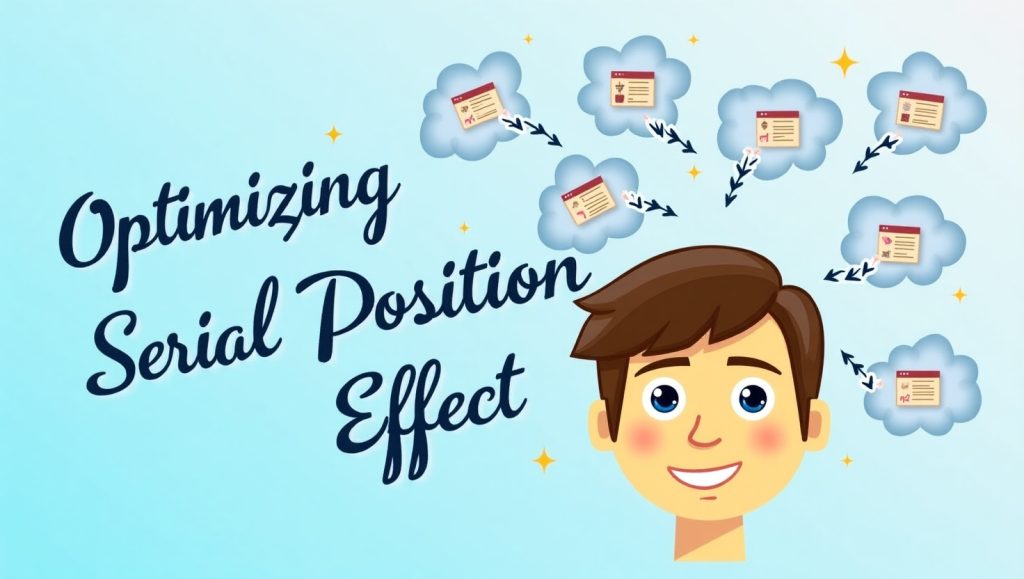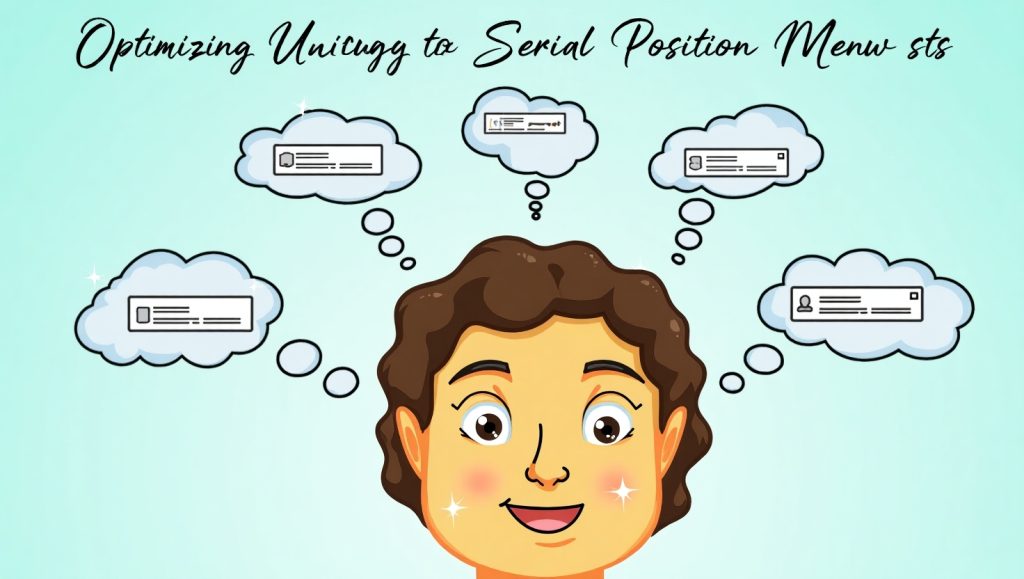
The Serial Position Effect is a psychological occurrence that affects how people remember sets of information that come in a sequence. In basic terms, people are more likely to remember the first and last items in a list, as opposed to things that happened in the middle of the list. This concept isn’t just interesting in theory—you can see its repercussions through User Experience design, particularly when factoring in the navigation menus for websites or apps.
Why is this relevant if you’re a web designer? Users scan menus quickly. They don’t actually read them, especially if you aren’t putting the links they should focus on in places where their eyes naturally look. If users can’t see your important links, that could equal lost clicks, higher bounce rates, and poor engagement overall.
In this article, we are going to dive into the psychology behind the Serial Position Effect and how it relates to menu design and specifically optimizing the start and end positions. We’ll provide actionable design attributions, backed up by user behavior data, so that you can create navigation that not only looks good but performs better.
Let’s get into it and discuss why it’s time to reassess our menu structure and take advantage of this powerful psychological theory.
Understanding the Serial Position Effect in UX
The Serial Position Effect is comprised of two specific cognitive systems: the primacy effect and the recency effect. Hermann Ebbinghaus was the first psychologist to propose the idea of the serial position effect in the late 19th century. Since then, decades of experimental research have examined the concept and supported its variability.
Primacy and Recency Effects Explained
When users see a list, they are more likely to remember:
- The first items (primacy effect) because those get more processing time and feel more important.
- The last items (recency effect) because they are freshest in memory.
This basic mental shortcut aids users in processing information rapidly, but that also means items in the middle are often lost. This is important to keep in mind when designing something like a navigation bar, which has a limited amount of space and where user attention is fleeting.
While UX design applies to many formats, in terms of digital interfaces, understanding the serial position effect and how it affects user experience can help us determine what we should prioritize, and what we should not. Rather than placing items in some nonsensical order, for example, UX designers can leverage the serial position effect and place key links at the forefront and the rear of a menu for additional visibility and interaction when developing their digital interfaces.
Why Menu Structure Matters in Digital Design
A navigation menu is so much more than a layout detail; it is the roadmap of your site. Whether your site has horizontal navigation along the top, or a hamburger menu on mobile, the way you are organizing it affects usability, retention, and conversions.
The Middle Gets Lost: Why Order Is Everything
Imagine your website has 7 main sections: Home, Services, Portfolio, Blog, About, Pricing, and Contact. Where do you put the most important one?
If you answered “first” or “last,” then you are already thinking like a UX strategist.
For example, if you put a super important page like “Services” first and also consider placing a Call to Action (CTA) like ‘Contact’ last. You are immediately maximizing the effect of the Serial Position Effect. Users are going to be more inclined to click on these links due to their perceptual prominence.
Links in the middle tend to go invisible. These poor links typically get under-used unless a user knows exactly where they are going on your website or is looking for something specific, because they become buried somewhere.
This is critical for small businesses and agencies, especially if you are a website design agency. If you can help potential clients to remember your portfolio page and contact page, you will 100% influence sales and leads through your website.
Applying the Serial Position Effect to Navigation Menus
Now that we understand the psychology, let’s get into the practical side. Here are some ways you can apply the Serial Position Effect to improve your navigation menu.
Place Key Links at the Start and End
Reorganizing your navigation makes it easier to show the importance of the different items. It may be helpful to put the highest-converting links like Contact, Pricing, or Get A Quote at either the beginning or the end of the list. You can put any secondary pages like Blog or Careers in the middle instead, as it’s reasonable to expect a user may still get to them despite middling importance.
If you’re advertising responsive web design, that service link at the beginning will be eye-catching to the user. If your site has a free consultation offer available, then putting “Contact” at the last position provides a strong impression.
Use Visual Cues to Reinforce Memory
The Serial Position Effect is not limited to the order of items. The visual hierarchy has the same importance. Things like bold text, button styles, or bold icons could leave the start/end items even more prominent. Even simple animation or hover can be used in such a way to provide some direction as to what’s most important.
The important thing is to make sure there is balance. Giving every menu item a dynamic visual cancels the effect. Use positioning and layout to direct users with just enough visual clean enough to stay clean.
Mobile Menus and the Serial Position Effect
Menus behave differently on mobile due to limited screen real estate. Still, the Serial Position Effect applies just as strongly—if not more.
The Scroll Factor: Top and Bottom Are Prime Real Estate
Generally, in hamburger menus, the scrolling is more rapid. Planner for links at the top of the panel (visible at opening) and bottom (just before closing) increases the likelihood those links will be noticed and tapped.
For instance, in the example of selling website design Cardiff, if you place that local service link at the top of the menu, it hooked right away. Then positioning the other call action: “Contact” or “Book Now” buttons at the bottom, reinforces the action you want them to take when they exit.
Bonus tip: Anchor or sticky bottom navigation bars are great places to take advantage of the recency effect and put high-impact links where thumbs naturally rest.
Case Studies: Navigation Menus Optimized With Serial Positioning
Let’s look at a few brands that have used this principle to their advantage.
Apple and Amazon: Order Drives Action
- Apple’s main navigation places “Store” at the start and “Support” at the end—two of the most essential pages for customer flow.
- Amazon uses a mega-menu, but when condensed, their top categories appear first, while “Customer Service” is reliably at the bottom.
These behemoths probably have run hundreds of tests to figure out what layout drives clicks and certainly you can think the same way on a smaller scale.
Even small businesses can leverage tools such as Hotjar or Crazy Egg to analyze menu performance and make changes to test different layouts.
If you have a digital agency site, or even a personal portfolio, give moving your most important page links to the front or end of your nav bar a try and see if it changes how people engage. You never know how significant an impact something as small as this can make.
Simple Tips for Better Menu Optimization Using Psychology

Here’s a short checklist to apply the Serial Position Effect today.
Tips for Smarter Navigation Design
- Start Strong – Lead with a key value page (like Services or Store).
- End with Action – Use the last slot for “Contact,” “Book Now,” or “Free Quote.”
- De-emphasize Middle Links – Place less urgent pages (e.g., blog, news) in the middle.
- Style Intelligently – Use buttons or contrast on first and last items to visually guide users.
- Test & Learn – Use A/B testing to evaluate different menu orders and track results.
Internal site structure affects user trust, satisfaction, and conversions. Implementing small UX psychology principles like this can make your web design strategy more user-friendly and result-oriented.
Conclusion
The Serial Position Effect is a reminder that it is often the presentation of something that matters more than the content. Your navigation isn’t just a list, it is a cognitive experience. By utilizing the way people encode information, you can enhance behaviors.
If used properly, this principle can enhance everything from time-on-site to your conversion rates. When building a site from scratch, or optimizing an existing site, consider the paths in which visitors’ eyes (and minds) will rove.